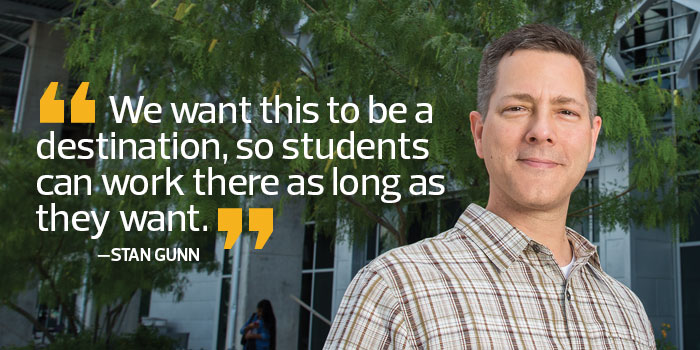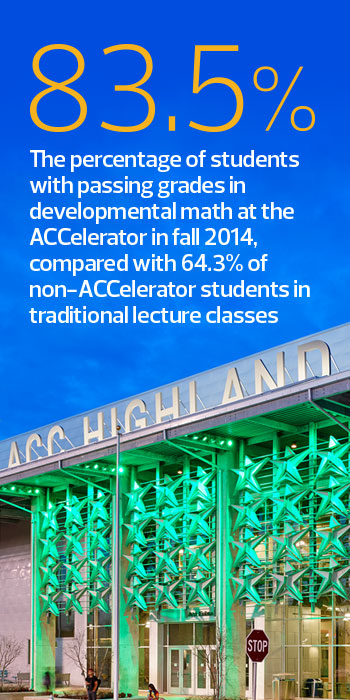Colleges Transform Off-Campus Sites into High-Tech Spaces
Big crowds used to visit Highland Mall in Austin, Texas, to shop, eat and hang out, but competition from new shopping complexes turned the city’s first indoor mall into a veritable ghost town. Now, Austin Community College (ACC) has revived an abandoned department store as a vibrant, innovative campus.
The heart of the space is the ACCelerator, a high-tech learning lab with 604 virtualized desktop computers, study rooms and classrooms. A network of faculty members, tutors and academic advisers roam the 32,000-square-foot space, ready to help when needed.
The lab’s unique environment makes it a less intimidating space, especially for first-generation college students, according to former director Stacey Güney, who recently became assistant vice president of academic affairs at Aims Community College in Colorado.
In fact, although the ACCelerator does offer traditional classes, one of its biggest successes since opening two years ago is an individually paced, web-based developmental math course, which has improved students’ performance in remedial math.

Stan Gunn, Vice President of IT, Austin Community College; Photo by Julia Robinson
“We were inspired by the space being a former mall — that culture where, even if you have no money to spend, you can go and hang out, and this space is capturing that,” Güney says. “It’s approachable.”
ACC joins a growing trend of colleges expanding into buildings originally designed for other purposes. For example, Virginia Tech, Panola College and the University of Iowa all have expanded into shopping malls.
Several factors are driving the trend. Some colleges, particularly in urban areas, have little room for growth. And with state budgets making it tougher to fund new buildings, it can be easier to expand by leasing or buying off-campus buildings and then renovating them, says Gary McNay, a higher education, technology and science market leader at architecture firm Perkins+Will.
Shopping malls also boast built-in advantages: convenient locations with bus and highway access and, in malls that are still busy, plenty of foot traffic.
Panola College’s Marshall College Center is in the middle of a mall near a main entrance. “It’s very noticeable, and people can see how busy we are,” says Laura Wood, the center’s director.
Creating A New Student Experience
When designing the ACCelerator, ACC administrators wanted to reimagine the student experience, creating a supportive atmosphere that integrates services and instruction. They accomplished it through careful use of architecture, furniture, staff and technology.
For starters, they renovated a drab, dark and outdated former JCPenney store into a modern, industrial-looking space filled with natural light. The spacious main room, which features four-person computer tables, is flanked by glass-walled study rooms with flat-screen TVs, classrooms with interactive whiteboards and informal study areas with tables and sofas.
Faculty members take advantage of the flexible space, Güney says. For example, an instructor can give a brief lecture in a classroom, then let students work on projects in the computer pods. “They have much more one-to-one time with students in this environment,” she says.
Most students need only a web browser and cloud-based software, so the ACC’s IT staff deployed virtual desktops using Dell Wyse thin client computers, 25-inch LED monitors and VMware Horizon 7 virtual desktop infrastructure software, says Stan Gunn, ACC’s vice president of IT. Standardizing on virtual desktops has simplified IT management and improved customer service, Gunn says. Through virtual desktop infrastructure (VDI), IT staff can remotely push out computer images to labs based on class needs, he says. The virtualized system has built-in redundancy, so if a server goes down, the images roll over to another server to keep operations running.
Becoming A Destination Space
During the renovation, IT staff installed a 12-inch raised floor to run CAT 6 cabling for the computer network. They built a 10-gigabit-per-second network backbone using Cisco Systems switches and deployed nine Dell PowerEdge servers and 27 terabytes of network-attached storage to power the virtual desktops.
Gunn also installed Wi-Fi throughout and extra electrical outlets at each computer table, so students can charge their mobile devices. “We want this to be a destination, so students can work there as long as they want,” he says.
So far, the ACCelerator has made a significant impact. Students from other ACC campuses flock to the lab to study and do their homework. In fact, the lab’s students have a 7 percent higher success rate in passing their classes, says Güney.
“Their retention rates are higher, and they’re getting better grades,” she says.

SOURCE: Austin Community College
A New Kind of Math Class
Austin’s ACCelerator was modeled after Virginia Tech’s Math Emporium, a 60,000-square-foot lab built in leased department store space at the University Mall in Blacksburg, Va., about a half mile from the main campus. The lab, which features 537 Apple iMacs, primarily serves eight self-paced freshman math courses, but also supports open study.
Terri Bourdon, the Math Emporium’s academic manager, says it is designed to facilitate collaboration. The lab features onsite tutors, lounges and conference areas for studying and group work. Classrooms host tutoring, orientations and weekly instructor-led help sessions. Clusters of hexagonal tables, each with six computers, make it easy for students to work together, Bourdon says.
Although the Math Emporium was built in 1997, Virginia Tech regularly updates the technology; for example, one-third of the computers are replaced every year. Currently, the math faculty is updating online courseware on the Drupal open-source platform.
Supporting Convenient Access
When Panola College, a community college in Carthage, Texas, wanted to better serve residents in the region, the Marshall Mall 26 miles north of the main campus was the perfect location for a satellite campus, Wood says. The mall offers easy highway access and is near a high school, making it convenient for students taking dual-credit courses.
The Marshall College Center, which opened in 2000, offers a robust selection of academic courses. And despite being a satellite campus, the college has made it a technology-rich environment, with Wi-Fi, LCD projectors and document cameras in every classroom. Recently, Allen West, the college’s IT director, upgraded both computer labs with 38 new desktop computers, and he will soon deploy a new mobile computer lab with 20 notebook computers.
A distance learning classroom lets students take courses in Carthage that are not offered in Marshall. Using Cisco Tandberg video conferencing equipment and high-definition displays, students can watch lectures and interact with faculty at the main campus, West says.
Students also manage administrative tasks in Marshall, such as transcripts, registration and tuition. In fact, every facet of the satellite campus is designed for convenient access to education.
The Power of Positive Thinking
Lee Webster, the assistant director of learning environments at Georgia State University, says that renovated spaces — with group tables, natural lights and lots of windows — foster a positive mindset. “If you walk into a room with dim lights and traditional armchairs, students are more inclined to be quiet and reserved,” he says. “A well-lit room with new paint and nice furniture will bring vibrancy and a sense of community.”
The same benefits apply to teaching, Webster says: “It allows professors to open the playbook, be creative and focus on more student-centered or peer-to-peer learning.”









